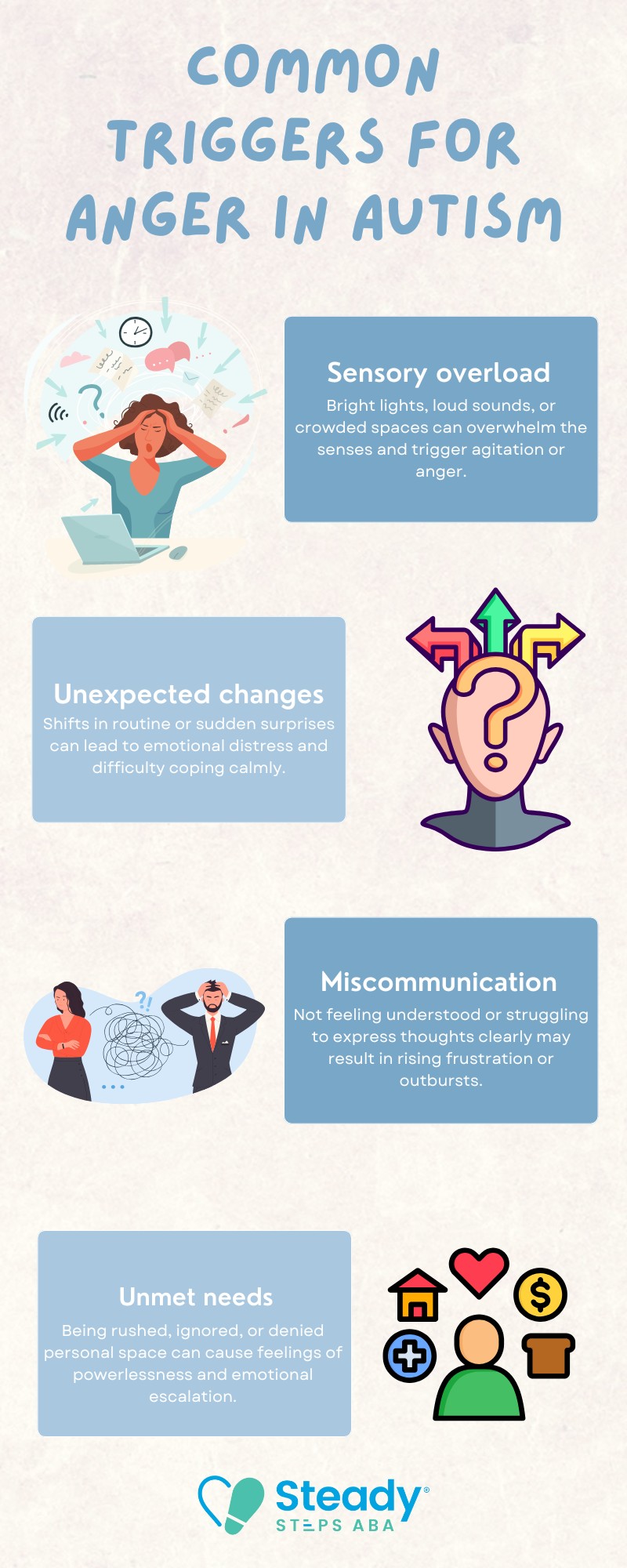Key Points:
- Autism-related anger may stem from sensory overload, unmet needs, or difficulty expressing feelings.
- Effective anger management techniques include proactive strategies, emotional regulation tools, and environmental adjustments.
- ABA therapy can help adults with autism learn personalized strategies to navigate intense emotions safely and effectively.
Understanding and managing anger in adults with autism requires more than simply calming someone down. According to research, up to 56% of autistic youth exhibit signs of physical aggression. For many autistic individuals, anger is not just an emotional outburst—it can be a response to overwhelm, anxiety, or a breakdown in communication.
Implementing anger management techniques for autism involves addressing the root cause, not just the behavior. Whether it’s a sudden shutdown or a more visible meltdown, these episodes can deeply affect an individual’s well-being and relationships.
In this article, we’ll explore practical, research-informed strategies that can help adults on the spectrum manage anger more constructively. If you’re a parent or caregiver, you’ll find concrete techniques like ABA therapy to support your loved one without judgment or guesswork.
What Are the Most Effective Anger Management Techniques for Autism?
Effective anger management techniques for autism involve recognizing triggers, using calming strategies, and teaching communication alternatives. Techniques such as sensory regulation, emotion labeling, and routine adjustments can make a meaningful difference. These approaches should be tailored to the individual and practiced proactively, not only during crises.
The most successful strategies focus on helping autistic adults feel safe, heard, and in control of their responses, without requiring them to mask or suppress their true needs. Below, we break down the tools and methods that work best across different situations and needs.
Why Is Anger Common in Adults With Autism?
Autistic individuals often experience the world in ways that are more intense and less predictable. Their neurological differences can heighten emotional responses, making it harder to regulate frustration or recover quickly from stress. Anger may emerge as a last-resort reaction to misunderstood cues, sensory discomfort, or social confusion.
Communication challenges also play a large role. If someone struggles to express what they feel or need, emotions can build up. When they’re unable to self-advocate or when routines are disrupted without warning, anger can surface quickly.
This doesn’t mean that every adult with autism will experience regular anger episodes, but for many, anger is a signal that something in their environment, routine, or interaction isn’t working.
What Are Common Triggers for Anger in Autism?
Recognizing what sets off anger is the first step in preventing it. Triggers can vary widely from person to person, but several common causes have been identified among autistic adults. Below are some examples:

Caregivers should observe patterns and keep a log of what tends to precede anger episodes. Even small shifts—like skipping a meal or a surprise visit—can play a role.
How Can Autistic Adults Learn to Recognize and Express Emotions?
Many adults with autism struggle with alexithymia, or difficulty identifying and describing emotions. This makes anger particularly challenging because the person may not realize what they’re feeling until it’s too late to manage it calmly.
Emotional literacy doesn’t develop overnight. But with consistent practice and support, autistic adults can learn to recognize their warning signs and name their emotions earlier, reducing the risk of emotional escalation.
Which Calming Strategies Work Best?
Once a person is aware of their emotional state, the next step is learning how to calm the nervous system. Calming strategies should be introduced during peaceful moments, not during an active meltdown.
Here are some effective self-regulation tools:
1. Deep Pressure Stimulation
Weighted blankets or firm, reassuring hugs (when welcomed) provide grounding feedback that can soothe the body and reduce anxiety.
2. Controlled Breathing
Breathing techniques like box breathing or slow counting regulate the nervous system and restore a sense of control.
3. Safe Physical Outlets
Walking away, jumping in place, or using stress balls provides a physical channel to release built-up tension or frustration.
4. Auditory Input
Soothing music, nature sounds, or noise-canceling headphones help reduce overwhelming background noise and ease sensory input.
5. Stimming Alternatives
Safe, repetitive motions like squeezing putty or rocking can channel emotional energy into manageable and calming activities.
These techniques should be individualized and accessible at all times, not just reserved for therapy sessions.

Can Environment and Routine Influence Anger?
Yes, the physical and emotional environment plays a massive role in emotional regulation. Environments that are unpredictable, overstimulating, or rigid can intensify anger. Below are environmental changes that often reduce stress:
1. Create Predictable Routines
Consistent daily routines and visual supports give structure, helping autistic individuals know what to expect. Predictability reduces anxiety, especially in unfamiliar situations, and provides a reliable framework for managing transitions and responsibilities.
2. Design Sensory-Friendly Spaces
Adjusting lighting, sound, and layout to match sensory preferences creates comfort and safety. Sensory-friendly environments reduce overwhelm, making it easier for autistic individuals to stay regulated and engaged in daily activities or social settings.
3. Provide Autonomy
Offering meaningful choices throughout the day fosters independence and reduces power struggles. When individuals feel respected and in control, they’re less likely to experience frustration or emotional dysregulation from imposed expectations.
4. Limit Multitasking Demands
Focusing on one task at a time minimizes cognitive overload and supports smoother transitions. Reducing simultaneous demands helps individuals stay present and process information without triggering stress or behavioral responses tied to executive function challenges.
Small, proactive environmental changes can prevent larger emotional outbursts. If the setup reduces confusion or overwhelm, the risk of frustration drops significantly.
How Can Parents and Caregivers Respond During an Outburst?
During an outburst, parents should remain calm, reduce stimuli, and ensure safety without demanding verbal interaction. Focus on creating a quiet, predictable space and use nonverbal cues or comforting objects if helpful. Avoid reasoning or punishing in the heat of the moment.
Once the outburst subsides, gently reconnect and support regulation. Processing what happened can wait until your child is calm. Remember, these moments are not about defiance—they’re usually signs of overload. Consistency, patience, and understanding make a significant difference in how frequently outbursts occur and how they’re managed.
What Long-Term Supports Can Help?
Long-term anger management involves building sustainable emotional and behavioral skills. This often includes therapy, education, and everyday practice. Below are strategies that offer long-term benefits:
1. Applied Behavior Analysis (ABA)
ABA teaches emotional regulation by reinforcing positive behaviors and breaking down triggers. It builds coping skills that can reduce anger responses in predictable, measurable ways over time.
2. Cognitive Behavioral Therapy (CBT)
CBT addresses negative thought patterns and emotional control. When adapted for autism, it helps individuals recognize emotions, reframe reactions, and manage stressors with more resilience and clarity.
3. Social Stories
These short, personalized narratives prepare individuals for stressful events. They clarify expectations, reduce anxiety, and provide mental rehearsal for appropriate responses in emotionally intense situations.
4. Peer Support or Group Sessions
Group sessions offer a safe space to share, listen, and learn from others facing similar challenges. Peer validation reduces isolation and fosters collaborative problem-solving.
5. Mindfulness Training
Mindfulness techniques like body scanning and guided breathing help individuals become more aware of internal states. With practice, this supports emotional balance and less reactive behavior patterns.
When therapy is consistent and individualized, it can significantly reduce episodes of unmanaged anger over time.
Build Confidence and Independence With ABA Therapy
Managing anger in autism is about understanding, not control. The techniques discussed here are designed to support long-term emotional health, not just stop a meltdown in the moment. For many families, having a professional guide this journey can make all the difference.
Steady Steps ABA offers personalized ABA therapy in Maryland, tailored to help adults with autism build emotional regulation skills and reduce outbursts rooted in frustration, anxiety, or sensory challenges.
Get in touch with us to learn how our ABA therapy programs in Maryland can help your loved one build lifelong emotional tools for managing anger, improving communication, and enhancing independence.






